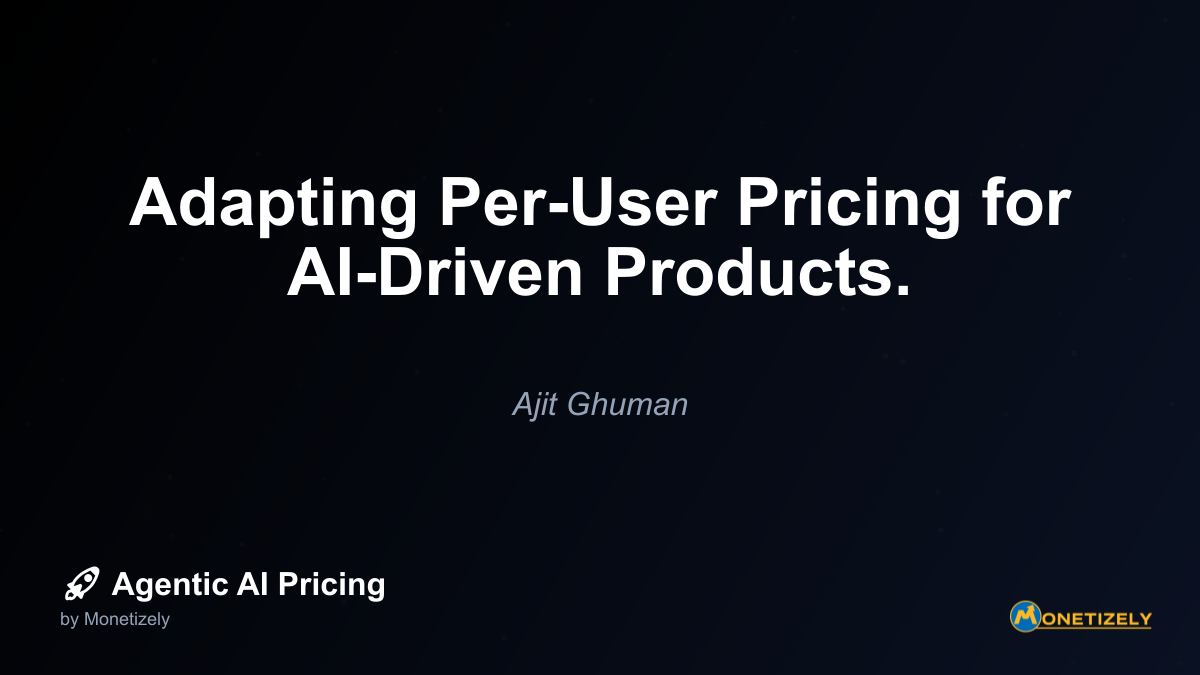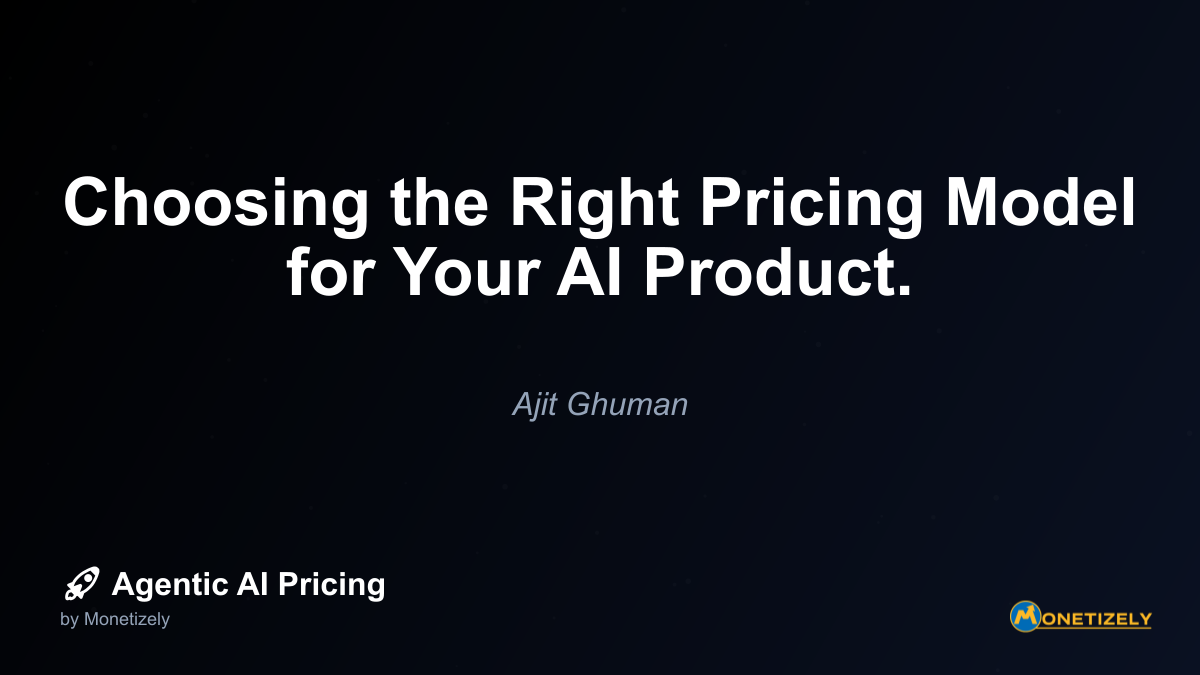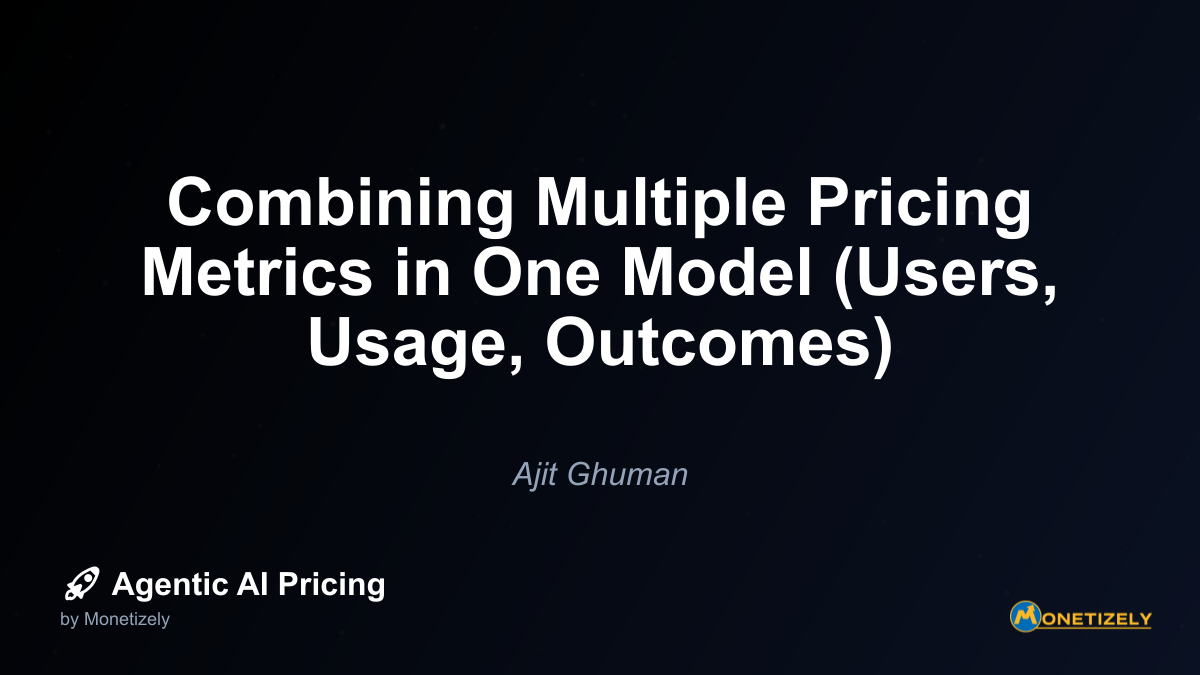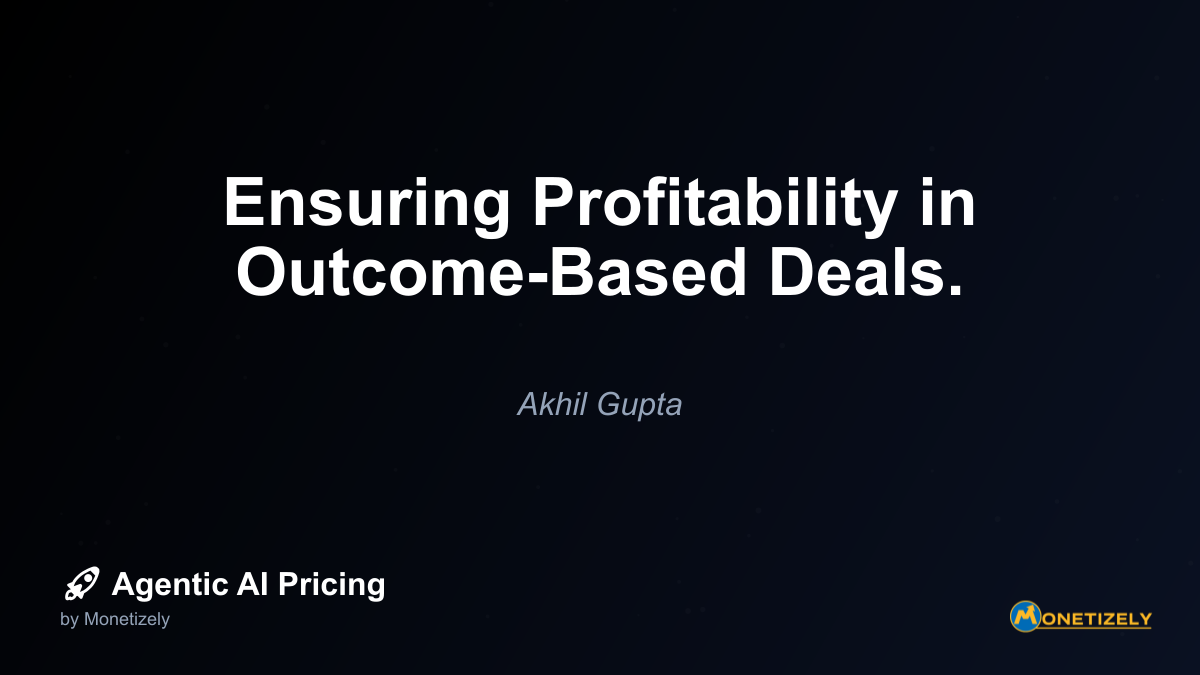· Ajit Ghuman · Agentic AI Pricing Strategies · 9 min read
Adapting Per-User Pricing for AI-Driven Products.
AI and SaaS Pricing Masterclass
Learn the art of strategic pricing directly from industry experts. Our comprehensive course provides frameworks and methodologies for optimizing your pricing strategy in the evolving AI landscape. Earn a professional certification that can be imported directly to your LinkedIn profile.

In the rapidly evolving landscape of artificial intelligence, traditional pricing models are being challenged by the transformative capabilities of AI-driven products. As AI agents increasingly augment human productivity, the conventional per-user pricing approach faces significant pressure. This tension emerges from a fundamental mismatch: while per-user pricing assumes relatively uniform value creation across users, AI tools can dramatically amplify individual productivity, creating scenarios where a single user might extract exponentially more value than the pricing model anticipated.
The Challenge with Traditional Per-User Pricing for AI Products
Per-user pricing has long been a cornerstone of SaaS business models, offering simplicity, predictability, and scalability. Customers understand it intuitively: more users equal higher costs. However, this model assumes a relatively linear relationship between user count and value derived.
AI-driven products fundamentally disrupt this equation. When an AI agent can perform tasks that previously required multiple human users, the traditional per-user model begins to break down. Consider a scenario where an AI writing assistant helps a single marketing manager produce content that would have required a team of five writers. Under a conventional per-user model, the company pays for one seat but receives the equivalent value of multiple users.
This value-extraction imbalance creates a significant challenge for vendors: how to capture fair compensation for the value delivered while maintaining the simplicity and customer acceptance of the per-user approach.
Understanding the Value Dynamics of AI Augmentation
Before exploring adaptation strategies, it’s crucial to understand the value dynamics at play when AI augments human capabilities:
Productivity Multiplication: AI agents don’t just incrementally improve productivity; they can multiply it, enabling one person to accomplish what previously required several.
Capability Expansion: AI tools often provide users with capabilities beyond their existing skill set, effectively expanding what a single user can accomplish.
Scalable Output: With AI assistance, a user’s output can scale dramatically without proportional increases in effort or time investment.
Varying Utilization Patterns: Different users will leverage AI capabilities to vastly different degrees, creating significant variability in value extraction.
These dynamics create a situation where the traditional correlation between user count and value derived becomes increasingly tenuous, necessitating adaptive approaches to per-user pricing.
Hybrid Models: Per-User with Usage Limits
One of the most promising adaptations is implementing a hybrid model that maintains the per-user foundation while incorporating usage limits or tiers.
Implementation Strategies
1. Tiered User Licenses
Rather than offering a single user license type, companies can create multiple tiers with varying AI usage allowances:
- Basic User: Limited AI interactions per month
- Power User: Expanded AI capabilities and higher usage limits
- AI Specialist: Comprehensive AI access with extensive usage allowances
This approach preserves the familiar per-user structure while acknowledging that different users will extract different levels of value from AI capabilities.
2. Per-User with Usage Caps
Another approach involves maintaining a standard per-user fee but implementing usage caps, such as:
- Maximum number of AI-generated outputs per month
- Limits on computational resources consumed
- Restrictions on specific high-value AI functions
When users exceed these thresholds, companies can implement various overage models:
- Pay-as-you-go rates for excess usage
- Temporary throttling of AI capabilities
- Option to upgrade to a higher user tier
3. Role-Based AI Access
Some organizations are implementing role-based pricing where different user types have varied levels of AI access:
- Viewer Roles: Minimal or no AI capabilities
- Contributor Roles: Moderate AI assistance for common tasks
- Creator Roles: Full AI capabilities for maximum productivity enhancement
This approach aligns pricing more closely with the organizational value different user types are expected to extract.
AI Capabilities as Add-Ons
Rather than embedding AI capabilities within the base per-user price, many companies are unbundling these features as premium add-ons.
Implementation Approaches
1. Base + AI Model
In this approach, companies offer a foundation per-user license that covers core product functionality, with AI capabilities available as optional add-ons:
- Base per-user fee: $X/month
- AI Assistant add-on: +$Y/month per user
- Advanced AI Capabilities: +$Z/month per user
This model provides pricing transparency and allows customers to selectively enable AI capabilities for users who will benefit most.
2. Feature-Specific AI Add-Ons
Instead of bundling all AI capabilities together, some companies are offering granular AI feature add-ons:
- AI Content Generation: +$X/user/month
- AI Data Analysis: +$Y/user/month
- AI Process Automation: +$Z/user/month
This approach enables precise value-based pricing and gives customers flexibility to select only the AI capabilities that deliver meaningful ROI for their specific use cases.
3. Consumption Credits for AI Features
Some vendors are implementing a hybrid model where users receive a base allocation of “AI credits” with their user license, with the option to purchase additional credits as needed:
- Standard User License: $X/month with 100 AI credits
- Additional AI credits: $Y per 100 credits
This approach balances predictable per-user pricing with the flexibility to accommodate varying AI usage patterns.
Usage-Based Components for AI Functionality
A growing trend is incorporating explicit usage-based components into per-user pricing models for AI products.
Implementation Options
1. Per-Output Pricing
This model charges based on the quantity of AI-generated outputs:
- Base user license: $X/month
- AI-generated documents: $Y per document
- AI data processing: $Z per gigabyte processed
This approach directly ties pricing to measurable value creation, though it can introduce less predictable costs for customers.
2. Computation-Based Pricing
Some AI products, particularly those involving complex models or large-scale data processing, implement pricing based on computational resources consumed:
- User license: $X/month
- AI computation: $Y per compute hour
- Model training: $Z per custom model iteration
This model accurately reflects the actual costs of delivering AI capabilities but may be less intuitive for business users without technical backgrounds.
3. Outcome-Based Components
More sophisticated pricing models are beginning to incorporate outcome-based elements:
- Base fee: $X/user/month
- Success fee: % of verified cost savings
- Performance bonus: $ per efficiency improvement milestone
While challenging to implement, these approaches align vendor compensation directly with the business value delivered.
Case Studies: Successful Adaptations
Enterprise Software with AI Copilot Features
A major enterprise software provider recently transitioned from pure per-user pricing to a hybrid model for their AI-enhanced platform:
- Standard user licenses: $75/user/month
- AI Copilot add-on: $40/user/month
- Usage limits: 200 AI-assisted operations per user per month
- Overage: $0.20 per additional AI operation
This model has allowed them to maintain their familiar per-user structure while capturing appropriate value from their AI investments. Early results show 60% of customers opting for the AI add-on, with average revenue per user increasing by 35%.
AI-Enhanced Creative Platform
A creative software platform implemented a tiered approach to accommodate varying AI usage patterns:
- Basic tier: $20/user/month (limited AI capabilities)
- Professional tier: $45/user/month (standard AI features with usage caps)
- Enterprise tier: $95/user/month (unlimited AI usage)
This structure has successfully addressed the “power user” problem, where a small percentage of users extract disproportionate value. The company reports more balanced distribution of users across tiers and improved customer satisfaction due to the alignment between pricing and value received.
Data Analysis Platform
A data analysis platform introduced a hybrid model combining per-user pricing with usage-based components for their AI features:
- Analyst license: $120/user/month
- AI analysis credits: 500 credits included per user
- Additional credits: $50 per 500 credits
This approach has provided pricing predictability while accommodating varying usage patterns. The company reports that the model has reduced customer concerns about runaway costs while still capturing appropriate value from heavy users.
Implementation Considerations
When adapting per-user pricing for AI-driven products, several key considerations should guide your approach:
Value Communication
Clearly articulating the value proposition of AI capabilities is essential for customer acceptance of adapted pricing models. Focus on:
- Quantifiable productivity improvements
- Concrete examples of time and resource savings
- ROI calculations demonstrating the business case
Customers are more likely to accept premium pricing or usage components when they understand the tangible value delivered.
Transition Strategies
For existing products adding AI capabilities, consider these transition approaches:
- Grandfathering: Maintain legacy pricing for existing customers while implementing new models for new customers
- Phased Introduction: Introduce AI features as optional add-ons before potentially incorporating them into core pricing
- Pilot Programs: Test adaptive pricing models with select customer segments before broader rollout
Thoughtful transitions can minimize customer disruption while enabling necessary pricing evolution.
Monitoring and Optimization
Implementing adaptive pricing requires ongoing monitoring and refinement:
- Track usage patterns to identify potential pricing imbalances
- Monitor customer feedback regarding perceived value and pricing fairness
- Analyze conversion rates and adoption patterns across different pricing tiers
- Be prepared to adjust thresholds and rates based on real-world usage data
The most successful companies treat AI pricing as an iterative process rather than a one-time decision.
Balancing Vendor and Customer Interests
The most sustainable pricing adaptations balance the legitimate interests of both vendors and customers:
Vendor Considerations
- Capturing fair compensation for the substantial value AI features deliver
- Recouping significant R&D investments in AI capabilities
- Maintaining sustainable margins as AI features increase delivery costs
- Creating pricing structures that scale appropriately with customer value
Customer Considerations
- Maintaining reasonable cost predictability
- Avoiding punitive charges for successful adoption
- Understanding the relationship between price and value
- Having flexibility to optimize costs based on actual usage patterns
The most successful models find the middle ground where vendors receive appropriate compensation while customers feel they’re getting fair value.
Future Trends in AI Pricing Adaptation
As AI technology continues to evolve, several emerging trends will likely shape pricing adaptations:
Outcome-Based Components: Increasing sophistication in measuring AI-driven outcomes will enable more direct connections between pricing and business results.
Dynamic Pricing: Advanced pricing systems may adjust in real-time based on the specific value being created for individual customers.
Ecosystem Pricing: As AI capabilities span multiple products, vendors may implement cross-product pricing models that reflect the holistic value delivered.
Self-Optimizing Models: Some vendors are exploring models where AI itself helps optimize pricing based on usage patterns and value creation.
These trends suggest that while per-user pricing will likely remain a foundation, the adaptations will become increasingly sophisticated in their ability to align price with value.
Conclusion
The integration of AI capabilities into software products necessitates thoughtful adaptation of traditional per-user pricing models. By implementing hybrid approaches that incorporate usage limits, tiered user licenses, AI add-ons, or usage-based components, companies can maintain the familiarity and simplicity of per-user pricing while addressing the value imbalances AI can create.
The most successful adaptations share common characteristics: they preserve some element of the familiar per-user structure, they create transparent connections between price and value, and they offer customers flexibility to optimize their costs based on actual usage patterns.
As AI capabilities continue to evolve, pricing models will likewise need to adapt. The companies that thrive will be those that view pricing as a strategic function requiring continuous innovation rather than a static decision. By thoughtfully adapting per-user pricing for the AI era, both vendors and customers can participate fairly in the tremendous value these technologies create.
Co-Founder & CEO
Ajit is the author of Price To Scale, a top book on SaaS Pricing and is the Founder of Monetizely. Ajit has led and worked in pricing and product marketing at firms like Twilio, Narvar and Medallia. His work has been featured in Forbes and VentureBeat. Ajit regularly consults with software companies from Seed stage to post-IPO on pricing strategy. Ajit is also a highly-rated co-instructor for 'The Art of SaaS Pricing and Monetization' on Maven.
Pricing Strategy Audit
Let our experts analyze your current pricing strategy and identify opportunities for improvement. Our data-driven assessment will help you unlock untapped revenue potential and optimize your AI pricing approach.




